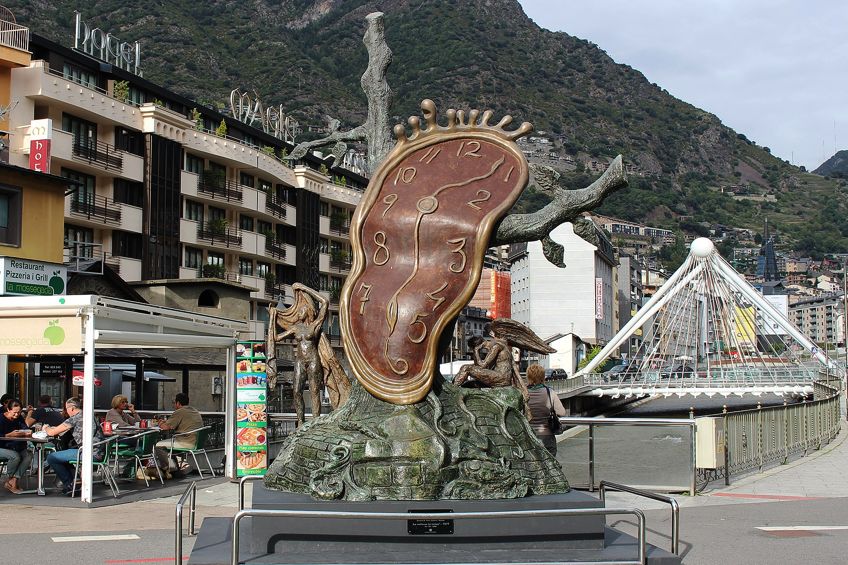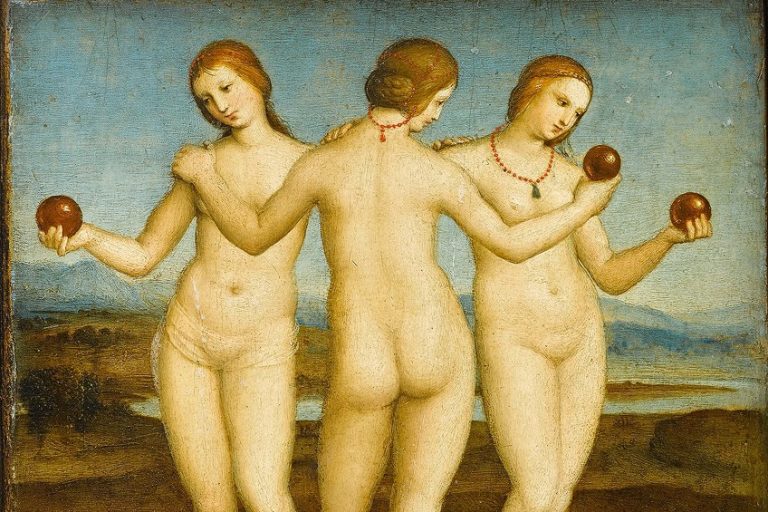The Persistence of Memory – Inspecting Dalí’s Melting Clocks Painting
One of the most creative artists to come from the Surrealism period of art was Salvador Dalí. Using dreams and hallucinations as his inspiration, Dalí went on to produce some of the most notable paintings that defined what the Surrealist movement stood for. His most renowned painting, and one of the most famous artworks to ever exist, is undoubtedly The Persistence of Memory, with his iconic melting clocks going on to become an instantly recognized symbol for his work.
Table of Contents
- 1 Who Was Iconic Surrealist Artist Salvador Dalí?
- 2 The Persistence of Memory: An Introduction
- 3 The History of The Persistence of Memory
- 4 Analysis of The Persistence of Memory
- 5 The Meaning of The Persistence of Memory
- 6 The Estimated Value of The Persistence of Memory
- 7 Fun Facts About The Persistence of Memory
- 7.1 The Painting Has Become Entrenched in Popular Culture
- 7.2 The Painting Is Smaller Than You Think
- 7.3 This Was the Painting That Made Dalí Famous
- 7.4 This Painting Speaks to the Scientific Advances of the Time
- 7.5 Other References to Time Are Made
- 7.6 Dalí Combined Different Genres of Art
- 7.7 The Olive Tree Has Significant Meaning
- 7.8 A Sequel to This Painting Exists
Who Was Iconic Surrealist Artist Salvador Dalí?
Spanish artist Salvador Dalí is often thought of as the head of the Surrealist group, as the paintings he produced during the movement stand out as the most noteworthy and celebrated. As one of the most versatile artists to come from the 20thcentury, Dalí is remembered as the most famous Surrealist member due to his incredibly flamboyant personality and indisputable technical skills.
His lengthy career also allowed him to experiment with a variety of mediums in addition to painting, which helped develop the type of artworks he was producing.
Joining the Surrealist group in 1929, Dalí displayed a deep fascination with the idea of subconscious art. This led to him painting in a sort of self-imposed hallucinatory state, which he later labeled as his “paranoiac-critical method”, which he used for the majority of his paintings. This method allowed Dalí to organize the confusion and delusions he was experiencing whilst in this semi-conscious state, which allowed him to completely reject the world of reality in his Surrealist artworks.
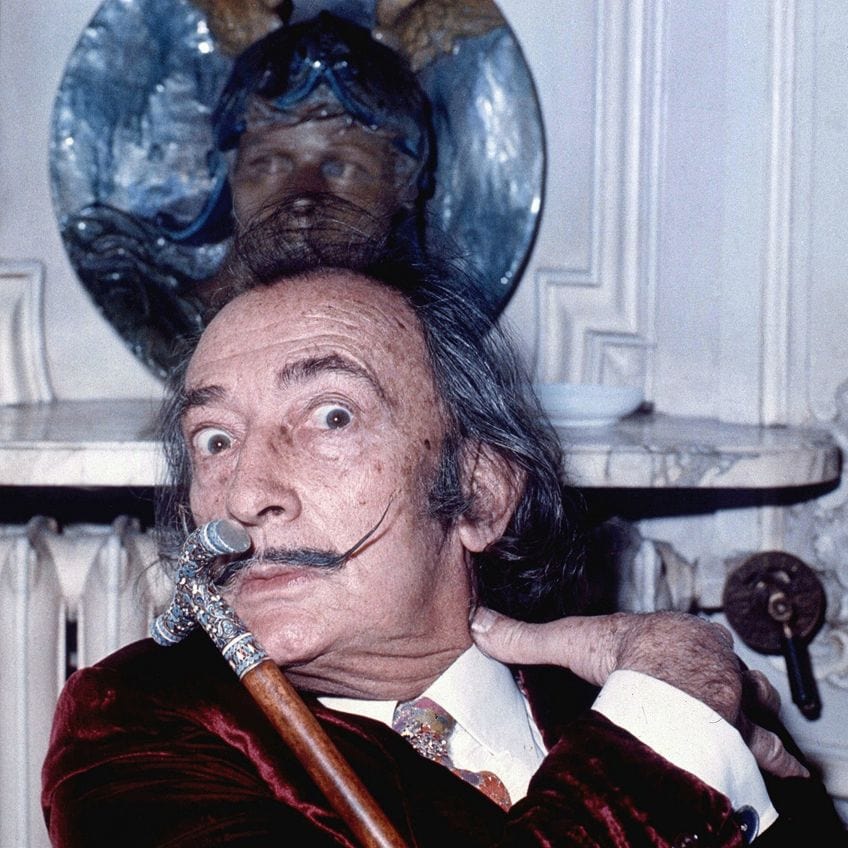
Dalí’s approach to painting delighted the other members of the Surrealist group, in particular its co-founder, Andre Breton. His ability to essentially tap into his own unconscious mind in order to control and stimulate the type of delusions he was experiencing, whilst still maintaining a handle on his own sanity, proved to be very impressive. This method of accessing seemingly random and illogical knowledge grew in popularity, to the point where other Surrealists began to experiment with Dalí’s approach to artmaking.
Displaying a deep fascination with the work conducted by Sigmund Freud, Dalí went on to create a type of visual language that was capable of rendering his dreams and hallucinations in all their glory. Despite his paintings appearing to be quite absurd at times, Dalí opened up an entirely new avenue of possibilities for Surrealists. This enabled other artists to begin inserting the personal, the mysterious, and the emotional into their paintings, which allowed truly bizarre and eccentric Surrealist works to be produced.
Within the majority of his works, Dalí looked to dreams for inspiration.
As the ability to dream was an operation conducted by the unconscious mind, Dalí saw sleep as a great tool that could be used to fuel his Surrealist practice. Frequently taking many brief naps throughout his days, these were said to help Dalí enter a fleeting hyper-associative state, which enabled him to bring together unpredicted associations and concepts in an effortless way.

As demonstrated within the majority of his paintings, Dalí was obsessed with the themes of eroticism, death, and decay. He represented these concepts in a variety of ways, especially through specific symbols that would recur in most works, which displayed his familiarity with them and his combination of psychoanalytical theories over time. Dalí frequently drew on his own autobiographical and childhood memories, making his works rife with symbolism that included his peculiar fetishes, animal images, and religious emblems.
Dalí’s enigmatic personality and exceptional draftsmanship helped lay his inner dream world bare for all the public to witness, which helped to evolve the concepts of Surrealism. Believing that life itself was the greatest form of art to ever exist, Dalí incorporated such passion and commitment into his work that eventually, no separation could be found between Dalí the man and Dalí the work.
Thus, due to his iconic style and techniques, it is easy to see why the impact that Salvador Dalí had on the art world is considered to be invaluable.
The Persistence of Memory: An Introduction
Painted in 1931, The Persistence of Memory is the most celebrated Surrealist painting created by Salvador Dalí. Translated to “La persistència de la memòria” in Catalan, this oil on canvas is one of the most recognizable artworks coming from the Surrealism movement and can easily be summarized in two words: melting clocks.
Existing as a universally recognized painting that has frequently been referenced in mainstream culture over the years, The Persistence of Memory has been given a variety of titles by which to recognize the artwork. Easily identified by names such as “The Soft Watches” and “The Melting Watches”, elements from this Salvador Dalí artwork have become iconic in their own right. Despite its size, as the canvas only measures 24 cm by 33 cm, The Persistence of Memory has achieved great heights of fame since it was painted.

As it has come to be seen as representative of the entire Surrealism movement, The Persistence of Memory attracts many visitors from all over the world. Depicting a dreamworld in which ordinary objects have been distorted and displayed in unusual and illogical ways, Dalí managed to bring an eerie landscape to life with unnerving accuracy.
When imagining how a clock would melt, Dalí’s depiction of the drooping, elongated, and distorted clocks accurately captures what they would possibly look like.
In an effort to materialize the irrational images that he saw in his hallucinatory states, Dalí went on to create a pictorial domain that executed Surrealist techniques with incredible accuracy. This precision is what was said to make The Persistence of Memory so surreal, as instead of depicting an imaginary world through hurried brushstrokes and whimsical colors, Dalí went on to paint common objects in unfamiliar ways.
The Persistence of Memory exists as an incredibly unique painting, as Dalí managed to expertly blur the line between reality and fantasy through his effortless integration of the real and the imaginary. Through melting objects within his painting in an incredibly realistic manner, Dalí creates a sense of uncertainty in his viewers, as the world of reality is entirely discredited.
However, this melting clocks painting does not just resemble a crazy hallucination. In fact, through the use of his paranoiac-critical method, Dalí actually hallucinated the entire scene before painting what he saw, which allowed him to create something that was so entirely “Dali-esque”. Thus, The Persistence of Memory exists as a type of dream photograph deliberately designed to confuse the viewer’s eye through its hyper-realistic images juxtaposed against impossible and dreamlike scenes.
The History of The Persistence of Memory
Displaying the deep grasp that he had on the elements of Surrealism, The Persistence of Memory was painted when Dalí was just 27 years old. Existing as one of his earlier artworks, this iconic depiction of melting clocks was said to have been inspired by The Garden of Earthly Delights, which was painted by Hieronymus Bosch between 1490 and 1510.
Additionally, this was also the first painting that Dalí successfully created using his paranoiac-critical method, as he represented his own psychological conflicts and phobias.
This method, created by Dalí in 1930, was thought to be very peculiar. Essentially, it was a technique that relied on self-induced paranoia and hallucinations to form, which went on to facilitate the creation of a painting. As it was seen as quite avant-garde at the time, this method became instrumental in the creation of the majority of Dalí’s artworks, as it allowed him to accurately create “hand-painted dream photographs” that were simultaneously rotted in realism and fantasy.
The Persistence of Memory was painted at the height of the Surrealist movement, with the melting clocks depicted effectively embodying the qualities and feelings that defined the experimental and eccentric genre. At the time, other Surrealists were exploring the concept of automatism, which was developed by the group’s co-founder, André Breton. Dalí’s wild approach to the movement was seen as somewhat extreme, as it demonstrated his inclination towards portraying peculiar subject matter that evoked dreams and challenged perceptions.
This melting clock masterpiece allowed Dalí to dive deep into his artistic mindset, which he thought to be innovative and free.
Dalí believed Surrealism to be quite destructive, however, it destroyed only what was seen as limitations to one’s vision. This allowed him to break free of any restrictions and completely immerse himself in his dream-like atmospheres, which helped in his creation of The Persistence of Memory.
Analysis of The Persistence of Memory
In this famous Salvador Dalí artwork, the actual inspiration being this painting is still up for debate, many art historians have gone on to argue about this over the years. At one point, Dalí ludicrously mentioned that he was in fact influenced by Camembert cheese when painting The Persistence of Memory, with this being the only piece of information he ever offered up about his artwork.
Dalí’s obsession with Freud’s theories relating to the unconscious mind and its ability to access hidden urges and delusions of the human mind can be seen in this painting. The instinctive fear of death is thus alluded to within The Persistence of Memory, as the dreamlike yet bizarre landscape that Dalí created evokes feelings of uncertainty and apprehension in viewers, as nothing is as it seems.

Believing in Freud’s theory so heavily, Dalí self-induced hallucinations when painting The Persistence of Memory and painted what he saw in great detail even though his hallucinations often terrified him. Refusing to deviate from his visions, this melting clocks artwork is full of Surrealist iconographs and characteristics that need to be fully analyzed in order to gain some grasp over the intention behind Dalí’s painting.
As every object in this dreamlike photograph was filled with elements of Surrealism, they all represented something meaningful to Dalí.
In an effort to bring his dreams into the real world, Dalí made use of methods that were unlike those used by any other artists, which helped make The Persistence of Memory truly extraordinary. The elements that stand out the most, which will be discussed in detail below, include the melting clocks, the figure lying in the middle of the work, the ants, and the familiar landscape.
Melting Clocks
The most well-known object within The Persistence of Memory is Dalí’s depiction of the melting clocks. Frequently called “soft watches” by many other Surrealists, these clocks are scattered across the composition and were said to represent Dalí’s theory of softness and hardness, which was a central tenet to his thinking at the time.
As time was demonstrated to be unreliable by the melting clocks, viewers were then able to assume that there was no guarantee of the other objects logically presenting themselves.
With the clocks appearing to be limp and merely draped over other objects, their softness demonstrates that the hard and sturdy concept of time essentially loses all meaning in the unconscious world. This was further indicated by Dalí, who labeled his clocks as the “Camembert of time”, which made absolutely no sense. Additionally, the juxtaposition of soft and hard was also said to represent the differences between reality and fantasy, as Dalí’s interpretation of real objects in such an illogical way renders them useless of their function
https://www.youtube.com/watch?v=HVYBGb7wtxs
By depicting the clocks as if they were dripping, Dalí experimented with the concept of expectations, as viewers expect to see a solid, well-constructed clock that can accurately keep track of time. Instead, we are greeted with a melted version that subverts this expectation and it makes no sense, as something so removed from how a clock should look is portrayed.
Within this dreamlike scene, with the numbers and hands of the clock melting into itself, there is no doubt that the concept of time does not function in an ordinary and reliable way.
Existing as the most memorable object in The Persistence of Memory, the melting clocks are unique to Dalí’s artwork. When asked if his clocks were inspired by Albert Einstein’s theory of relativity, Dalí simply replied that they were a Surrealist perception of cheese melting in the sun. As this motif went on to become so memorable, Dalí reincorporated it into a variety of his other paintings throughout his career, such as The Disintegration of the Persistence of Memory (1952 – 1954).
Anthropomorphic Form
Said to be a self-portrait of Dalí, this human-like figure lying in the middle of the painting has been the subject of much debate. While some elements of the distorted figure have been speculated to be representative of Dalí, the figure has also been compared to an alien or a monster. Lying completely motionless, a limp clock appears to be draped over the figure’s back in a way that brings about images of a saddle on a horse.
Known for his unconventional self-portraits, this form could very well be a partial portrayal of Dalí, as it does show some sort of resemblance.
A nose can be made out at the top of the figure that points in the direction of the bottom of the composition, with a closed eye next to it. Directly underneath this, enlarged eyelashes are shown, which take up the majority of the left side of the figure.
Dalí went on to use this anthropomorphic form in several of his other paintings and they were always thought to represent himself. The abstractedness of the form allows it to fit into the surreal and dreamlike background well, as none of the other objects appear to make any logical sense. Thus, this deformed figure could very well be Dalí, just as the melted clocks can no longer tell the time.
With the figure’s eye also being closed, one can assume that it is also in a dream state. This was said to represent the titled experience that Dalí had whilst he was hallucinating, with this strange creature being the product of his visions and delusions. The clock weighing the figure down demonstrated that the persistence of time will always remain, whether one was awake or dreaming. While we may never know if this figure is a self-portrait of Dalí or not, it exists as the most popular answer, given his interest in exploring his own subconscious in his art.
Congregating Ants
The inclusion of ants in The Persistence of Memory was important, as they represented the concept of decay, which was frequently touched on in Dalí’s other works. Seen to be crawling over the only pocket watch that has remained unmelted and thus retaining its structure, the notion of deterioration seems absurd as metal cannot decompose.
Ants hold special meaning to Dalí, as their destructive tendencies were explored in a variety of ways in his artworks.
Pictured on top of the pocket watch, it can be assumed that they were looking for any crumb of sustenance to keep them alive. This makes the absurdity of the watch stand out even more, as a metal watch cannot act as a substitute for food. When compared to the fly, a sign of disease, sitting on the melting clock above, the ants can easily be recognized as agents of destruction
Perhaps the decay that these ants represent was in fact in reference to their own deterioration, as without food they would eventually die. Painted in hyper-realistic detail, the group of ants seems to be frantically crawling over the watch in an effort to find something. Both the group of ants and the pocket watch that appears on top of the platform are considered to be strange. The gathering of ants represents the only group within The Persistence of Memory, with the closed pocket watch is the only face-down clock in the entire composition.
It has been speculated that this orange pocket watch was a later addition to The Persistence of Memory, which was added to create extra emphasis. However, as Dalí never provided any explanation for his painting, this will always remain a theory. The intense shade of the orange helps draw attention to the ants, as their black bodies contrast heavily against the bright color. While there is no reason to believe that the pocket watch and ants were added last, the clarity with which they were painted demonstrates their importance to Dalí.
Familiar Landscape
While the rough landscape in the background of The Persistence of Memory may look like an ordinary, natural formation of rocks, it was actually inspired by Dalí’s home, Catalonia. More specifically, the vague coastline that can be seen in the back of this painting was inspired by the coastal peninsula of Cap de Creus, which was close to where Dalí lived.
Despite this connection to the background, it was said that Dalí’s primary reason for using such an empty setting was to create a clear visual space for the surreal story that was unfolding.
The triangular shadow that appears to be seeping across that canvas was believed to be a reference to Mount Pani, which was seen multiple times in a variety of his other paintings. The shadow that encapsulates half of the composition creates a foreboding effect, as one gets the feeling that something strange is taking place.
As the landscape was based on Dalí’s hometown, its depiction was said to include a piece of Dalí within The Persistence of Memory, in addition to the anthropomorphic form that was thought to be a self-portrait of him. This made the work incredibly personal, as many references to Dalí could be seen in this dreamlike scene.
Within the landscape itself, almost no features appear. A seemingly dead olive tree is shown to be growing out of an enormous square platform, while another platform can be seen closer to the water. The lifeless tree was thought to demonstrate the dull and lackluster nature of this dreamscape, as nothing had the ability to grow and prosper. Instead of growing larger, the only purpose that the olive tree has in this composition was to hold up one of the melted clocks.
The Meaning of The Persistence of Memory
What makes The Persistence of Memory so intriguing, is that Dalí never provided an explanation for his painting. Therefore, all of the analyses that have been made up about this painting over the years remain simply conjecture, as no one can confirm or deny these theories.
Dalí was said to have given a lecture at the Museum of Modern Art in New York City, where he spoke about the meaning of The Persistence of Memory. Instead of providing some clarity, Dalí simply stated that viewers should rest easy if they found it difficult to understand the work, as he himself did not know what it meant either.
After this declaration, art critics, scholars, and audiences were given plenty of room to impose their own understanding onto the painting, which means that the theories that exist are based on other’s comprehension.
In an effort to form some sort of understanding about The Persistence of Memory, many have looked to the artwork’s title for more information. Due to this, it is not an unreasonable assumption to state that the clocks in the painting speak about the concept of the passage of time in both reality and dreams. Despite Dalí merely associating the clocks with French cheese, they have been said to represent the persistence of time, even though they appear in this completely surreal landscape where time itself does not seem to exist.
By taking familiar objects, distorting them, and placing them out of any recognizable context, Dalí represented the power of his hallucinations and visions. While many aspects can be debated, one thing becomes clear: the success of The Persistence of Memory was so powerful, that it placed both Dalí and this painting at the pinnacle of Surrealism.
The Estimated Value of The Persistence of Memory
This iconic Salvador Dalí clocks painting has actually never been sold at auction, as it has remained at MoMA for over 80 years now. Given that its current owner is an art museum dedicated to the importance of art and cultural history, it is unlikely that The Persistence of Memory will ever be sold to a private benefactor. Despite this, the estimated value of The Persistence of Memory can be deduced by looking at the costliest purchase of a Dalí painting to date, in addition to the sales of other Surrealist artworks.
Dalí’s most exorbitant painting ever sold was his Portrait de Paul Eluard, which he painted in 1929. This artwork was sold for just under $22.5 million in 2011, which provides a good baseline value for The Persistence of Memory. However, in recent years, the paintings of many iconic Modern artists such as Pablo Picasso, Mark Rothko, and Jackson Pollock have all gone on to sell for between $100 million and $200 million.
This is because collecting original artworks has become a practice that only the extremely wealthy can engage in, which has significantly raised the value of art.
Due to this, it can be assumed that The Persistence of Memory will fetch a higher price if it were to ever be sold. Thus, through comparisons to Dalí’s other works in addition to iconic paintings produced by other Modern artists, it is likely that The Persistence of Memory is valued anywhere between $50 million and $150 million.
Where Is The Persistence of Memory Currently Located?
First exhibited at the Julien Levy Gallery in New York in 1932, The Persistence of Memory has remained part of an art collection ever since. Anonymously donated to New York’s Museum of Modern Art (MoMA) in 1934, it has never left the gallery and has attracted plenty of visitors throughout the decades. If you are ever in New York, you can go and visit The Persistence of Memory for yourself, as it is housed in the Collection Galleries of the museum.
Fun Facts About The Persistence of Memory
Exhibited for the first time at the Galerie Pierre Colle in Paris in 1931, The Persistence of Memory was also shown at the very first Surrealist exhibition that occurred in the United States in the same year. When the painting was acquired by the Julien Levy Gallery in 1932, Dalí and his wife, Gala, accompanied the painting in third class after Pablo Picasso financed their travel.
At this point in his career, Dalí has been formally banned from the Surrealist group, as his political opinions did not align with the movement’s other members. Additionally, he displayed a great enjoyment of American popular culture, which Surrealism co-founder André Breton and his fellow European artists greatly detested.
However, the irony remains that the artwork that went on to become the most iconic Surrealist painting to ever exist was sent to America, along with Dalí, where it remains today.
The Persistence of Memory is one of the most over-analyzed paintings to ever exist, yet some facts about the painting are not as well-known as others. Below, we will go through eight fun facts that you may not have known about The Persistence of Memory before today.
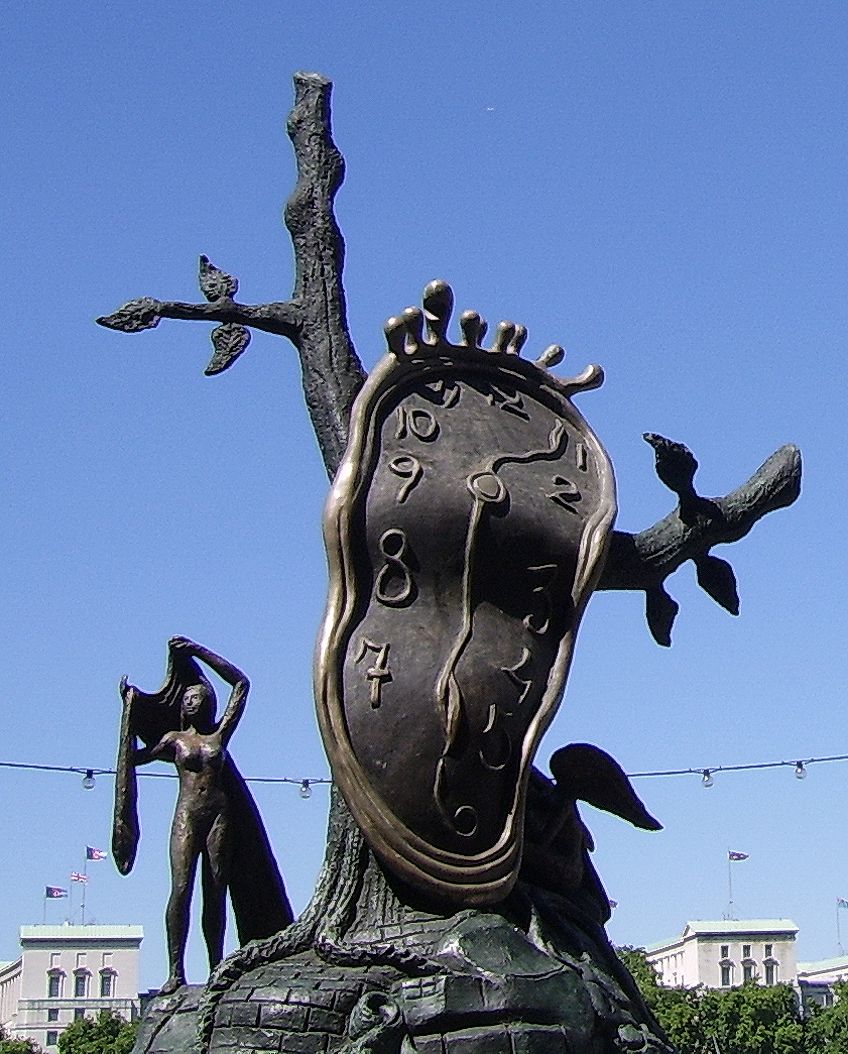
The Painting Has Become Entrenched in Popular Culture
As the years have gone on, The Persistence of Memory has been referenced in popular television shows, which has demonstrated its popularity despite the passage of time. The shows that have mentioned the artwork include The Simpsons, Hey Arnold, Futurama, Doctor Who, Looney Tunes, and Sesame Street.
From these shows, one of the most recognized caricatures is said to come from The Simpsons, in which all members of Homer Simpson’s family are depicted as the different objects from the original artwork. Marge Simpson’s face is seen melting off the platform with her iconic blue hair pooling onto the ground in a liquified state, while the strawberry-frosted donut associated with The Simpsons draws the attention of the ants.
Another significant parody is the one created by Sesame Street, where the sleeping Cookie Monster takes the place of Dalí’s self-portrait, and melting cookies are depicted in place of the melting clocks. As The Persistence of Memory went on to become so widely spread throughout the years, it already had a cult-like status by the time it was donated to the MoMA.
The Painting Is Smaller Than You Think
Slightly bigger than an A4 piece of paper, The Persistence of Memory is much smaller than most people initially think. As it went on to become such a renowned painting, that was synonymous with the entire Surrealist movement, one would think that a work of its status and popularity would be larger than 24 centimeters by 33 centimeters (9.5 inches by 13 inches).
This Was the Painting That Made Dalí Famous
Painted when he was just was 27 years old, The Persistence of Memory is the artwork that put Dalí on the map, as he reached significant levels of fame after his painting was exhibited. Thus, this painting can be seen as Dalí’s big break in the artwork, as the American public went crazy for him when The Persistence of Memory was unveiled at the Julien Levy Gallery in 1932.
This Painting Speaks to the Scientific Advances of the Time
The Persistence of Memory is said to refer to the scientific advances that existed at the time that Dalí painted the artwork. While he stated that Freud’s theories of the unconscious mind went on to inspire him to create such Surreal works, other critics have stated that Einstein’s Theory of Relativity was what actually influenced The Persistence of Memory. This is demonstrated by the distorted references that Dalí made to space and time within this work, as his iconic melting clocks were thought to be an unconscious symbol of relative time.
Other References to Time Are Made
In addition to the quintessential melting clocks within The Persistence of Memory, other references to time are thought to appear. The grains of sand, seen in the deserted background, were said to refer to the sands of time and the sand found in an hourglass, while the bodies of the ants were depicted by an hourglass shape.
Additionally, the shadow that can be seen hanging over the composition was thought to represent the passing of the sun, signifying a change in the time and day, while the distant ocean represented the concept of eternity.
While no time can be inferred from the three melting clocks depicted, different concepts of time were thought to be symbolized by the inclusion of three clocks exactly. The past, present, and future were each said to be represented by one of the clocks, while the pocket watch was believed to signify objective time, further emphasized by lying face-down on the platform.
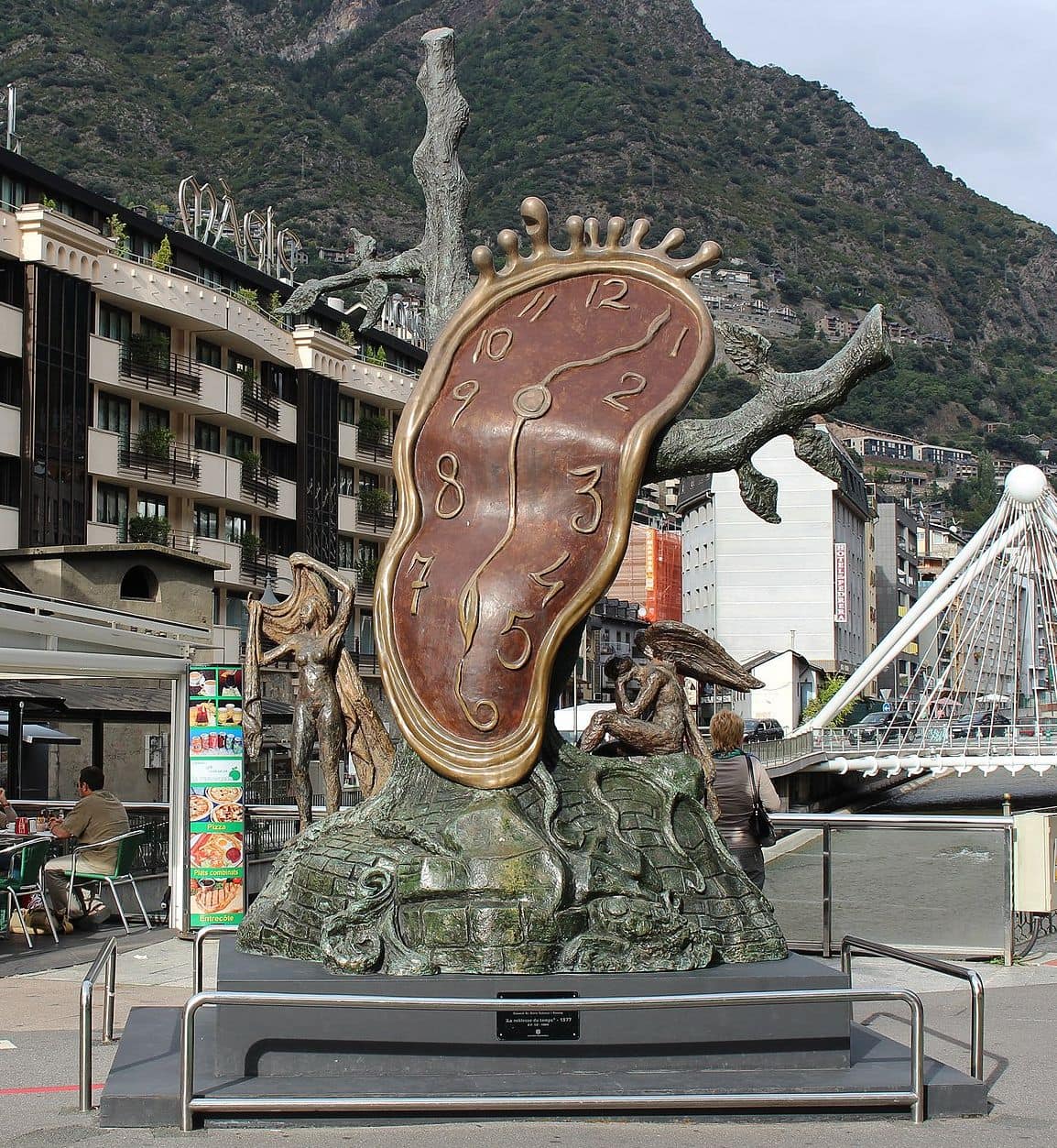
Dalí Combined Different Genres of Art
Another reason that made The Persistence of Memory so remarkable was that Dalí was able to include three different art genres in one single composition. A still-life, self-portrait, and landscape can be seen through the different elements of the work, namely the lifeless objects, the human-like form in the center, and the bare Catalonian background respectively.
The Olive Tree Has Significant Meaning
Despite appearing to be completely devoid of any life and vitality, the inclusion of the olive tree was said to be politically motivated. While an olive branch typically represents peace, its integration within The Persistence of Memory represented the death of peace, as the political climate of Dalí’s home country between the two World Wars was full of turmoil. Additionally, by portraying the branch to be broken, Dalí was said to be emphasizing the agitation that existed in Spain during the build-up to the Spanish Civil War in 1936.
A Sequel to This Painting Exists
As the melting Salvador Dalí clocks became so iconic, he went on to include them in a variety of his other works and even created a sequel to The Persistence of Memory. The new painting, which revisited the composition explored in his original work, was titled The Disintegration of the Persistence of Memory and was painted between 1952 and 1954.
Originally titled as The Chromosome of a Highly-colored Fish’s Eye Starting the Harmonious Disintegration of the Persistence of Memory, this oil on canvas represented Dalí’s prior artwork being broken down into its basic atomic elements. After returning to the elements of The Persistence of Memory 20 years later, Dalí updated his new artwork so that it accurately reflected the more modern anxieties of nuclear warfare that were prominent in society at the time.
As he had an incredibly lengthy career, many iconic artworks were produced by Dalí that reached dizzying levels of fame. However, ‘The Persistence of Memory’ remains the greatest work ever produced by Dalí, as well as the most celebrated painting to emerge from the Surrealist movement. Nearly 100 years since its creation, this painting still captivates the interest of critics and audiences alike, with the unbridled and nonsensical dreamland created by Dalí going on to both puzzle and intrigue individuals when viewed.
Take a look at our melting clocks painting webstory here!
Isabella studied at the University of Cape Town in South Africa and graduated with a Bachelor of Arts majoring in English Literature & Language and Psychology. Throughout her undergraduate years, she took Art History as an additional subject and absolutely loved it. Building on from her art history knowledge that began in high school, art has always been a particular area of fascination for her. From learning about artworks previously unknown to her, or sharpening her existing understanding of specific works, the ability to continue learning within this interesting sphere excites her greatly.
Her focal points of interest in art history encompass profiling specific artists and art movements, as it is these areas where she is able to really dig deep into the rich narrative of the art world. Additionally, she particularly enjoys exploring the different artistic styles of the 20th century, as well as the important impact that female artists have had on the development of art history.
Learn more about Isabella Meyer and the Art in Context Team.
Cite this Article
Isabella, Meyer, “The Persistence of Memory – Inspecting Dalí’s Melting Clocks Painting.” Art in Context. July 4, 2021. URL: https://artincontext.org/the-persistence-of-memory/
Meyer, I. (2021, 4 July). The Persistence of Memory – Inspecting Dalí’s Melting Clocks Painting. Art in Context. https://artincontext.org/the-persistence-of-memory/
Meyer, Isabella. “The Persistence of Memory – Inspecting Dalí’s Melting Clocks Painting.” Art in Context, July 4, 2021. https://artincontext.org/the-persistence-of-memory/.


